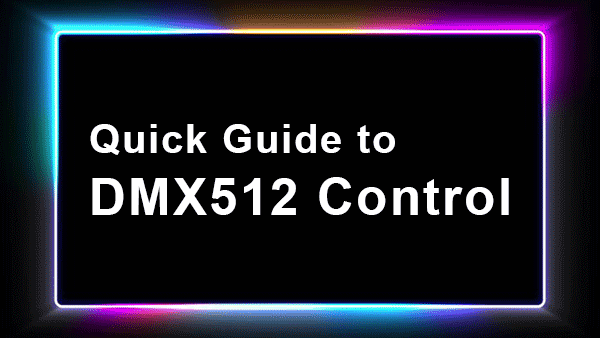The impact of DMX512 on lighting control goes through the past, present, and future, marking a significant shift in the way lighting systems are designed, operated, and experienced. Since its emergence in the 1980s, DMX512 control has revolutionized the lighting industry by providing a standardized protocol for controlling lighting fixtures, overcoming the challenges posed by proprietary systems and incompatible protocols. In the past, DMX512 addressed the fragmentation and inefficiencies inherent in pre-existing lighting control methods, laying the groundwork for a new era of creativity and innovation in lighting design. Today, DMX512 remains the backbone of professional lighting applications, enabling precise control, seamless integration, and dynamic effects across a wide range of industries and settings. Looking to the future, DMX512 continues to evolve alongside advancements in technology, sustainability, and industry practices, shaping the trajectory of lighting control and paving the way for new possibilities in immersive experiences and environmental consciousness.
History of DMX512
Before the invention of DMX 512, stage lighting manufacturers relied on a multitude of proprietary cable types, each incompatible with the others. This lack of standardization led to considerable frustration and redundancy within the industry.
1. 1986: Development: DMX512 was developed by the United States Institute for Theatre Technology (USITT) as a standardized protocol for controlling lighting dimmers.
2. 1990: Introduction of DMX512/1990: The DMX512/1990 standard was introduced, specifying the electrical and mechanical characteristics of the protocol. It allowed for the control of up to 512 channels of lighting data over a single cable.
3. Rapid Adoption: DMX512 quickly gained popularity in the entertainment industry due to its simplicity, reliability, and flexibility.
4. Evolution and Revisions: Over the years, the DMX512 protocol saw several revisions and updates to improve performance, address compatibility issues, and support newer lighting fixtures and effects.
5. Legacy Use: Despite the emergence of newer protocols, DMX512 remains widely used in the entertainment industry for controlling lighting and special effects equipment.
6. Continued Support: Many lighting fixtures, control consoles, and other equipment still rely on DMX512 for communication, and it continues to be supported by manufacturers and industry persons.
7. Industry Standard: DMX512 has become the standard for lighting control in theaters, concert venues, nightclubs, and other entertainment spaces.
8. Global Impact: DMX512′s standardized approach to lighting control has had a significant impact globally, providing a common language for lighting professionals to communicate and collaborate effectively.
9. Integration with New Technologies: While newer protocols like Art-Net and sACN have emerged, DMX512 remains relevant and continues to be integrated with newer technologies to meet the evolving needs of the entertainment industry.
10. Foundation for Innovation: The widespread adoption of DMX512 has laid the foundation for innovation in lighting design and control, enabling lighting professionals to create immersive and dynamic experiences for audiences worldwide.
What is DMX512?
DMX512 is a standardized protocol used in the entertainment industry for controlling lighting and special effects equipment. It stands for Digital Multiplex 512, indicating its ability to control up to 512 channels of lighting data over a single cable. DMX512 provides a common language for lighting controllers to communicate with lighting fixtures, allowing for precise control over brightness, color, movement, and other parameters. This protocol has become the industry standard for lighting control in theaters, concert venues, nightclubs, and other entertainment spaces due to its simplicity, reliability, and flexibility.
What is 512 Channels?
The “512 channels” in DMX512 refers to the number of individual control parameters that can be addressed and manipulated within the protocol.
1. Individual Control Parameters: Each channel represents a specific attribute of a lighting fixture or effect, such as brightness, color, pan, tilt, strobe, or other effects. For example, a simple RGB LED fixture might have three channels—one for red, one for green, and one for blue—allowing precise control over each color component.
2. Range of Values: Each channel can typically accept values between 0 and 255, representing the full range of control for that parameter. For example, a channel controlling brightness might have a value of 0 for off and 255 for full intensity.
3. Total Control: With 512 channels available, DMX512 provides extensive control over lighting setups, allowing lighting designers to create intricate and dynamic effects by adjusting multiple parameters across multiple fixtures simultaneously.
4. Fixture Compatibility: Different types of lighting fixtures require varying numbers of channels to control their full range of functions. Some fixtures may only require a few channels for basic control, while others, such as moving lights or pixel-mapped LED arrays, may utilize dozens of channels or more.
5. Channel Assignment: Channels are typically assigned sequentially, with each fixture or effect occupying a block of channels corresponding to its number of control parameters. For example, a fixture with five control parameters might occupy channels 1 through 5, while the next fixture would begin at channel 6.
6. DMX Universes: In larger lighting setups, multiple DMX512 universes may be used to accommodate more than 512 channels. Each universe operates independently, with its own set of 512 channels, allowing for virtually unlimited scalability in lighting control systems.
Overall, the 512 channels provided by DMX512 offer lighting designers a powerful tool for creating dynamic and customizable lighting effects in a wide range of entertainment applications.
Post time: Aug-30-2024

